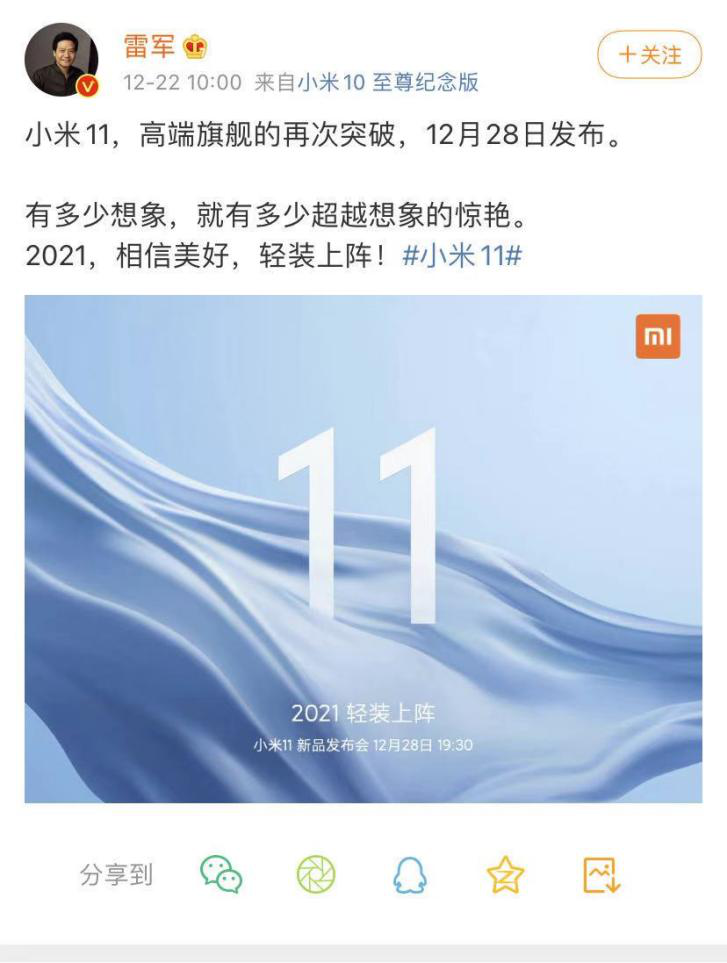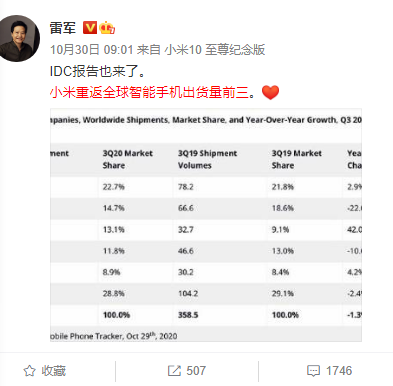“Do the world’s best mobile phones, but also sell high-priced”
Editor’s note: This article is from the micro-channel public number “letter list” (ID: wujicaijing), Author: Zhang Ruya.
From 2020 to 2021, when the old and the new alternate, Lei Jun announced on Weibo that Xiaomi will launch a new model “Xiaomi 11”. This is the third high-end mobile phone released by Xiaomi in a year.
The screenshot is from Lei Jun’s Weibo
On February 13 this year, at the Xiaomi Mi 10 conference, Lei Jun repeatedly emphasized that “this is the first time that Xiaomi has really hit the high-end market.” The starting price of the Mi 10 series is 3999 yuan, and the top price is 5999 yuan, which is the highest price ever for the Mi series.
Half a year after the release of the Mi 10 series, Xiaomi launched the Mi 10 Extreme Commemorative Edition on August 11, and the price of 6,999 yuan once again exceeded the price ceiling of Xiaomi.
The price is so expensive, are rice noodles willing to pay? Xiaomi’s Q3 financial report shows that as of October 2020, Xiaomi’s high-end devices (priced at more than 3,000 yuan in China and more than 300 euros abroad) have sold more than 8 million units worldwide.
For Xiaomi, now is a rare window of time. Xiaomi Mi 11 was launched at the end of the year, obviously there are factors in this regard. Due to the US sanctions, the glory of independence, and the slowdown of the Huawei system, it undoubtedly alleviated the pressure on Xiaomi’s competition. The market gap left by Huawei in Europe and the delayed release of the iPone12 series gave Xiaomi an opportunity to expand its market share. Shows that Xiaomi’s mobile phone shipments in Western Europe increased by 107.3% year-on-year.
Before the official announcement of Snapdragon 888, Lei Jun posted the latest report from the market research agency IDC on Weibo on October 30, stating that “Xiaomi will return to the top three global smartphone shipments”. In this quarterly report, Xiaomi is the company with the largest increase, and it has bucked the trend during the epidemic.
According to Xiaomi’s 2020 third quarter financial report, the company’s total revenue was 72.2 billion yuan, a year-on-year increase of 34.5%, and the adjusted net profit was 4.1 billion yuan., An increase of 18.9% year-on-year.
Revenues and profits hit new highs, and there is a high probability that smartphones will be credited. Xiaomi’s smartphone revenue in the quarter reached 47.6 billion yuan, with shipments of 46.6 million units, a year-on-year increase of 45.3%.
On December 23, Xiaomi’s stock price rose nearly 8% to close at 31.9 Hong Kong dollars per share, and its market value exceeded the 800 billion Hong Kong dollar mark, setting a new high since its listing. The next day, Xiaomi’s stock price still showed an upward trend, rising by 1.72%. Closed at 32.45 Hong Kong dollars / share, the market value remained above 810 billion Hong Kong dollars. Another company with a market value of 100 billion U.S. dollars was born on China Internet.
The launch of Xiaomi 11 may push Xiaomi to further expand its share of high-end mobile phones. However, it is obviously too early to say that Xiaomi has broken through the bottleneck and occupy a pivotal position in the high-end phone market.
According to the city survey agency IDC released the title “The Long Overdue 5G iPhone, Will It Be “Flying like Flying” afterwards? According to the analysis report, the market in the price segment above $600 where the iPhone 12 series is located has a market capacity of 23.5 million units in the first half of 2020.
From the perspective of market share, Huawei surpassed Apple with 44.1% market share, ranking first, followed by Apple with 44% share, and the two together accounted for 88.1% of the high-end machine market share. Surprisingly, Samsung, which accounts for 2.5%, is less than OPPO’s 2.6% market share.
Although Xiaomi ranks third, its market share is only 4%, which is a huge gap with Huawei and Apple. With Xiaomi’s 11 product, it may be difficult to bridge the gap.
More difficult to break than the high-end market is the user’s existing impression of Xiaomi.
On November 18th, Lei Jun gave a speech at the 2020 Yabuli Forum Annual Conference, using Xiaomi’s return to the top three in the world as an introduction to clarify three misunderstandings about Xiaomi: “Xiaomi products are all low-end products” and “Xiaomi products” It’s all OEM”, “Xiaomi has no technology.”
These three misunderstandings represent the general user’s general impression of Xiaomi, which is of course not accurate. However, since it has been formed, breaking or even reshaping the brand image is far from a speech.
A
One thing is clear, simply raising the price does not guarantee Xiaomi’s entry into the high-end market.
In the 2020 Q3 financial report, the average price of Xiaomi mobile phones was 1022.3 yuan, an increase of 15.8 yuan year-on-year. The Mi 10 series brought certain growth. However, it is obviously not established to use this to determine the success of Xiaomi’s high-end counterattack.
Comparing Xiaomi’s 2018 Q3 financial report data, the average price of Xiaomi mobile phones reached 1052 yuan. At that time, Xiaomi officially stated in response to the financial report that “mobile phones grew against the trend and stabilized in the high-end market.” Then Xiaomi CFO Zhou Shouzi explained in the conference call “Station Stabilize the high-end market” means 2000The mobile phone market above RMB.
One year later, in Xiaomi’s Q3 financial report for 2019, the average selling price of mobile phones fell to 1,006 yuan.
Expensive does not mean “high-end”, but high-end is definitely expensive. Lei Jun himself said, “What do you understand about high-end mobile phones? Are they expensive? I don’t know. However, I think only when Xiaomi products stand in the middle of expensive products can everyone truly recognize our efforts.”
Lei Jun
The price is only the appearance, the important thing is whether the brand image fits the high-end positioning. When it comes to Huawei Mate series and P series, users will naturally position them as “high-end”, followed by “expensive” prices.
In the minds of the general public, Apple and Huawei are high-end products that are very expensive. On the contrary, looking at Xiaomi, it is difficult for consumers to have similar thinking inertia. This is the result of the brand image.
Ten years ago, Xiaomi started with mid-to-low-end devices at RMB 1999. Lei Jun, a “mobile phone layman”, has stepped into the smartphone industry from the Internet, software, and investment all the way, with a set of “Internet thinking”-extreme, focus, word of mouth, fast ——Bring Xiaomi to today.
The development of Xiaomi today is inseparable from early users, that is, middle and low-end users, who are the basic disk of Xiaomi mobile phones. The “cost-effective” gene is a label that Xiaomi can’t get rid of from beginning to end.
Xiaomi has made many attempts. In January 2019, the Redmi brand was spun off for independent development in order to allow Redmi to take charge of the mainstream market, that is, Xiaomi’s mid- and low-end users, while Xiaomi went lightly to the high-end market.
In the two years of “separation”, Redmi has been developing rapidly in the low-end market. When it comes to “cost-effective” mobile phones, Redmi is the first. This may be a bad thing for Xiaomi. To be a high-end market, Xiaomi must improve its brand building. Consumers who buy Redmi still value “Xiaomi” in essence. On the other hand, Redmi attached to Xiaomi will have an impact on the Xiaomi brand to a certain extent.
To some extent, brand image determines the price of mobile phones. For example, some of Huawei’s low-end 1000 yuan machine, Huawei Maimang 8 has been complained by netizens that “e-waste can be sold 1899”. The reason for this is because of Huawei’s boutique strategy since 2010, which determines that Huawei’s mobile phones have premium capabilities, and their thousand yuan phones are much more expensive than other mobile phone manufacturers.
B
Whether Xiaomi can achieve the “class transition” from low-end to high-end products depends on whether the times give opportunities.
In 2017, domestic smartphones accounted for 48% of global sales. Huawei ranked first, followed by manufacturers such as OV and Xiaomi, and of course mobile phone brands such as Meizu, Hammer, Gionee, and OnePlus. The only high-end phones above 4000 yuan are Samsung and Apple. Except for Gionee M2018 and 8848 titanium phones, there are almost no domestic brands making high-end phones. This is undoubtedly a blue ocean.
Lei Jun once said that a pig can fly when standing on a tuyere. Huawei is the flying “pig”.
In 2018, no one on the market made high-end devices, so Huawei dared to be the first person to eat crabs. First of all, Huawei has Kirin chips. If all Qualcomm chips are combined with Xiaomi’s strong and stable position in the low-end market, it will be difficult for Huawei to escape, but with Kirin chips, Huawei can step out of differentiation and enter the high-end market in one fell swoop. .
Huawei has its own research and development technology, whether it is triple-camera, Leica, or EMUI that has not been stuck for 18 months, or GPU Turbo. This determines that Huawei has more selling points, while Xiaomi is a mobile phone assembled through a large number of high-end accessories. , Which makes Xiaomi mobile phones uncompetitive in terms of technology.
In addition to Huawei’s influence at home and abroad, consumers will choose Huawei rather than Xiaomi for the same 5,000 yuan mobile phone. The reason is that Xiaomi’s civilian route lacks some background, making the public more willing to pay for high-end models.
C
On December 16, 2009, Lei Jun’s 40th birthday. It was two years before he left Jinshan that day. Four months later, he founded Xiaomi. In the next 10 years, Xiaomi counterattacked listed companies with a market value of more than 800 billion Hong Kong dollars from a hardware layman.
“To be the best mobile phone in the world, but only sell for half the price.” Xiaomi embodies the ultimate price-performance ratio on every mobile phone as much as possible. A few years ago, when the first Xiaomi mobile phone was finalized at the last minute of 1999 yuan, Xiaomi decided The future direction and the bottlenecks it will inevitably encounter.
It has countless fans with its high cost performance. As the most “mass-based” mobile phone brand, Xiaomi was labeled with Internet thinking, cost-effectiveness, black technology, geeks, etc., and the glory behind it was mixed with inexplicable helplessness. The fragmented, unclear and cost-effective brand image has not only made Xiaomi, but also trapped it.
Looking back at Xiaomi in the past 10 years, both consumer product recognition and brand recognition have been built on the cornerstone of cost-effectiveness. Once the price-performance ratio is lost, Xiaomi also loses its soul.
It is undeniable that cost performance is a very good selling point. All domestic mobile phone brands, including Huawei, have covered the low-end market. One of Xiaomi’s former rivals, Meizu, initially focused on high-end positioning, but then the price of new products dropped all the way toAbout two thousand.
Because of the low price, domestic mobile phone brand shipments were ahead of high-end phones Samsung and Apple before 2014, but it also led to the long-term monopoly of the profits of the mobile phone industry by Samsung and Apple.
In 2013, Samsung was in an awkward position in the Chinese market. Samsung sold less than 15.3 million units in China in the second quarter of that year, but these sales data did not translate into revenue growth. The US$11.3 billion in sales from the Chinese market accounted for 16.4% of total net sales, compared with 20.4% in the same period last year. . You know, before this, Samsung can easily monopolize the Chinese market, which gives domestic brands a chance to win the chase.
Huawei and other manufacturers were trying to carve up the market space of Samsung Note large-screen mobile phones, but Xiaomi was still addicted to the low-end market. In September 2014, at the IFA 2014 Berlin Consumer Electronics Show, Huawei released the 6-inch flagship mobile phone Mate7, which claims to be able to compete with Apple and Samsung in the high-end market. According to public data that has not been verified by Huawei, as of the end of the year, the sales of Huawei Mate7 exceeded 1.5 million units. Even though there is still a certain gap between the shipments of Samsung and Apple, Huawei had a good opportunity to seize the high-end market at that time. .
To some extent, Xiaomi has already missed the high-end large-screen market in 2014.
For many years, the domestic mobile phone pattern has been surging. Qualcomm and other chip manufacturers are iterating rapidly. The cost of new products is getting higher and higher. According to Xiaomi’s consistent low price path, the cost will be difficult to maintain, which is very detrimental to its subsequent development. .
After missing the large-screen high-end market, a series of realities have forced Xiaomi to change, and the road to high-end has become the strategic direction of Xiaomi.
Ten years ago, Lei Jun resolutely devoted himself to the mobile phone Red Sea to make Xiaomi. Whether his intentions really lie in the mobile phone, he had to ask a question mark. On July 22, 2014, at the Xiaomi press conference, Xiaomi Mi 4 met with the public.
This mobile phone is different from the past. It has added the “Mi remote control” function, which is marked to control TV, cable TV set-top boxes, air conditioners, network set-top boxes, DVD players, air purifiers, fans, light bulbs and other home appliances. Explain that these devices can be controlled directly with only one mobile phone. This shows on the side that Xiaomi has started to deploy smart homes at least six years ago.
Half a year after the Xiaomi 4 conference, Xiaomi purchased 1.29% of Midea at a price of 1.266 billion yuan. This is an important step in Xiaomi’s deployment of smart homes, which means that as long as a 22-yuan Xiaomi smart chip is implanted in the partner’s electrical appliance, the Xiaomi mobile phone can be used as the center to connect itself and all smart devices of the United States.
The smart home industry involves a huge number of upstream and downstream, and it has not yet reached the explosive stage, and it will take a long time for high-end family groups to penetrate in first-tier cities. The important thing is that Xiaomi’s young user base and smart homeThe audience is extremely different. This requires Xiaomi to change its positioning and establish its own high-end user group in order to truly reach the smart home.
Nowadays, high-end is the only way for Xiaomi to go up. As Lei Jun said, in today’s market, if you want to live on the report card of the past, you can’t keep it. “We only have to emancipate the mind, put down the burden, and start again.”
However, the burden has been put down. Will some low-end users who have followed Xiaomi for a long time also be put down?


